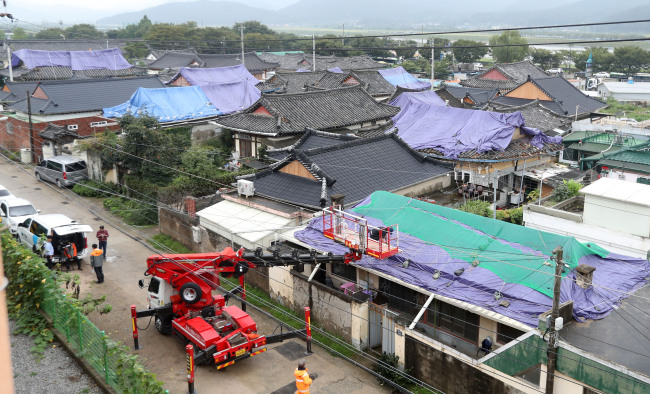The government and the ruling Saenuri Party on Sunday held an emergency meeting and decided to review whether to designate the quake-hit southeastern city of Gyeongju as a disaster area to provide it with state funding for recovery works.
They also agreed on the need to strengthen safety measures against earthquakes and prepare detailed guidelines to measure the damage of public facilities, houses and cultural assets. They also discussed ways to support the citizens of Gyeongju from any psychological impact.
The meeting at the National Assembly was attended by the party leadership including Chairman Rep. Lee Jung-hyun, along with the ministers for agriculture, food and rural affairs, vice minister for public safety and the head of the Korea Meteorological Administration.
The government and the ruling party agreed to firstly determine the extent of the earthquake damage in Gyeongju by sending a joint investigation team to the site, prior to the designation.
The capital of ancient Silla (57 B.C. to 935) was hit by a 5.8-magnitude earthquake Monday with the tremors felt throughout most of South Korea. The KMA said the quake was the strongest since 1978, raising alarms over the safety of the country that had been previously considered “earthquake-free.”
On Saturday, officials at the North Gyeongsang Provincial Government and Gyeongju City Council requested the central government to designate the city as a disaster area to cope with the damage with the help of a fund of 5 billion won ($4.4 million).
An area with a calculated loss of 7.5 billion won can be designated as a special disaster area, according to Vice Minister Lee Sung-ho of the Ministry of Public Safety and Security.
Meanwhile, the Ministry of Trade, Industry and Energy said Sunday that it would complete safety tests on all of 24 units of the country’s nuclear plants by the end of 2018. Tests for the Kori and Wolsong nuclear plants located near the epicenter in Gyeongju will be completed by the end of next year.
Korea Nuclear Power Co., operator of the country’s nuclear plants, said last week that despite two tremors in Gyeongju, the plant near the city and other plants in the adjacent areas were fully functional without error, producing electricity as per normal.
Officials said the planned safety tests are to make sure the power plants are built to withstand an earthquake with a magnitude of up to 7.0.
Currently, two units at the Kori nuclear plants and four units at the Wolsong nuclear plants have ceased operation due to maintenance and accident-prevention checks.
There has been rising concern about current regulations on earthquake-resistant construction.
According to Rep. Chong Jong-sup of the Saenuri Party, South Korea lacks specific and detailed earthquake-resistant construction regulations for safe building designs.
“The government should make earthquake-proof construction design mandatory for all constructors in case of building or remodeling, and establish a legal basis to strengthen construction safety for buildings without earthquake-proof design,” said Rep. Chong.
He said he is preparing a revision bill to improve the current Act on the Preparation for Earthquakes and Volcanic Eruptions as well as the Building Act.
The enforcement decree of the Building Act, which took effect in 1988, states that buildings six stories or higher with total floor area of 100,000 square meters must be built following earthquake-proof designs.
In 2015, the legislation was revised to target buildings three stories or higher with an area of at least 500 square meters.
Earlier this year, buildings two stories or higher came under the law to have more buildings made using earthquake-proof methods.
Yet the lack of earthquake-proof facilities across the nation have been considered problematic.
According to the Ministry of Land, Infrastructure and Transport’s data, in 2015, just 26.7 percent of buildings three stories or over 13 meters high in Seoul were built based on earthquake-proof designs. The total figure across the country was slightly above 34 percent.
Meanwhile, seismic experts have also raised concerns that the Korean Peninsula is no longer safe from strong shock waves and may experience severe earthquakes of magnitude 6.0 or greater.
The Korean Peninsula was previously considered safe from earthquakes, as it is located away from the Pacific seismic belt “Ring of Fire.”
According to the KMA, however, small and mid-sized earthquakes have occurred over the past three decades. A total of 1,212 earthquakes were detected since 1978, and six of them have been earthquakes with a magnitude exceeding 5.0.
Oh Chang-hwan, a professor of earth environment at Chonbuk National University said that the Korean Peninsula has been experiencing a 400-year cycle of 7.0 magnitude tremors since mid-1600.
Along with the active fault located by the east coast of the peninsula, experts added that strong tremors that originate from nearby epicenters can also cause extensive damages.
“When strong shock waves are detected in nearby countries such as Japan, it may add on to the shock waves felt by the Korean Peninsula,” said Hong tae-kyung a professor of earth system science at Yonsei University.
“Earthquakes of magnitude over 7.0 can create more secondary shocks in neighboring areas, which last from five to a maximum of eight years,” he added.
By Kim Da-sol (
ddd@heraldcorp.com)








![[Today’s K-pop] Blackpink’s Jennie, Lisa invited to Coachella as solo acts](http://res.heraldm.com/phpwas/restmb_idxmake.php?idx=644&simg=/content/image/2024/11/21/20241121050099_0.jpg)